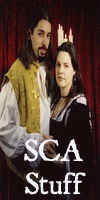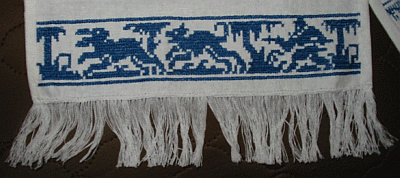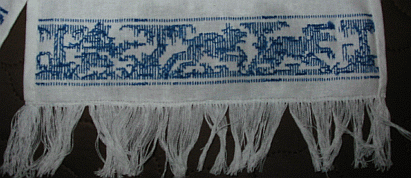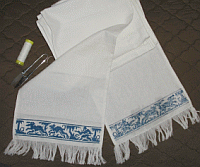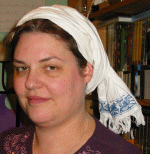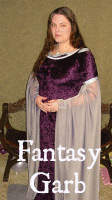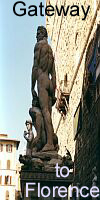
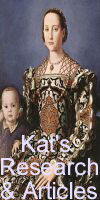
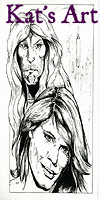
|
1st February, 2006:(well November, 2005
really)
While I have the embroidery bug, I am finally going to try some
Assisi work on the end of a turban-styled wrap headdress that can be
found in Florentine portraits. Three can be seen below. I have based
mine mainly on the first one (I have a very similar dress!) with a
band of Assisi work and a fringe. This will be a very practicle piece
of headwear for camping!
|
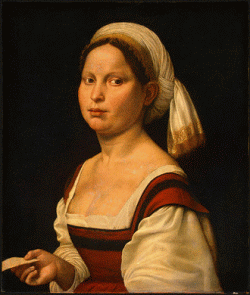
Giuliano Bugiardini Portrait of a Young Woman, 1525
|
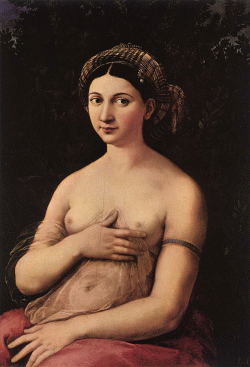
|
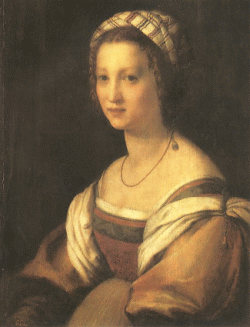
|
|
|
Portrait of a Young Woman (La Fornarina) Raffaello
1518-19
|
Portrait of the Artist's Wife by Andrea del Sarto
, 1513-1514
|
I had sort of started this a few months back, having seen a cute
bunny pattern. There was a Worshipful Company of Broiderers
competition running on 'bunnies'. I did not have time then to do it
(let alone finish it). The competition was extended to Festival this
year, so I decided to get off my proverbial and do it!
|
Background:
During the 16th century, various states in Italy were
involved in politics and trade with the East and 'fighting
the Turks'. Some fashion was influenced by this also.
Turbans can be seen in the above pictures. (Turkish coats
were seen in Venetian portraits.)
Dressing Renaissance Florence mentions that
Florentine women publicly wore cappucci wound up in a turban
(p 157) in the 15thC. Though this was not common. Men could
also wear turbans which were publicly acceptable (p283).
Pictorial evidence is found of women wearing turban like
headwear in the 16th century, as seen in the above portraits
of more influencial women.
Some pictures show the linen head wear both wound and
non-wound in the previous century. Wrapping it was practicle
and would keep it out of the way when doing work or at home.
Sassetta's Birth of the Virgin (Tuscany). shows
half-wrapped linen. (from Italian Renaissance
Interiors)
|
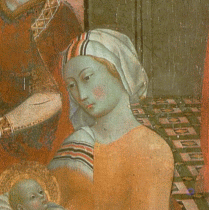
|
Pattern:
These appear to be long strips of (linen) wound around the head. I
also looked into Eastern turbans, as this fashion was most likely
influenced by the trade and conflicts with the East. Most articles
seem to mention strips of linen, from '6-18 inches' wide and '4-12
yards' long. I decided on just over 7 inches by 4 yards. I did not
want too boofy a turban and this was the width of the embroidery
pattern. (March: looking back now, I will make my next turban
wider...)
Decoration:
The first visual example I have, has a white cloth strip with
embroidered decoratoin on the end.
Initially, I had a photocopy of the pattern (full pattern seen below
Right) but it was incomplete. It was originally from a pattern book
by Newall (p 14) Needlework Patterns from Renaisance Germany-
Designs charted from Johan Sibmacher's Schon Neues Modelbuch 1597.
(In the WCOB article on Bunnies:
www.sca.org.au/broiderers).
I tried to get a copy of this book, but could not. Fortunately
there was also a copy of the pattern in The Needles Excellency A
New Booke. This was published in 1631 but has the same pattern as
in the 1597 Modelbuch. (Cover below) This is downloadable of the
internet.
|
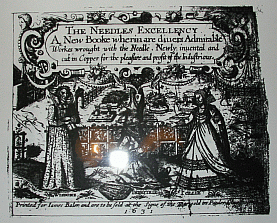
|

|
My Turban:
Here is the embroidery. I have decided I hate counting all those
little threads! I made three of the linen's threads equal one square
of the above pattern. I added an extra tree on the left to give a
slightly wider width. This is my first attempt at Assissi work and
the first time I have done any form of cross stitch. The embroidery
is done in long-arm cross stitch. Research I have done suggests that
this is a period method. I preferred the 'more filled in' look of
this form. As I have not done this form of embroidery before, I am
unsure on how the back should look exactly.
I used Medera silk thread, using it in single strands.
The edges have a fringe, created by handsewing with linen thread
along near the edge, pulling the threads (ah, something else I would
learn to do....), and using a blanket stitch to create an edge to
hold the fringe. A fringe can be seen on Sassetta's Birth of the
Virgin and Giuliano Bugiardini's Portrait of a Young
Woman, 1525, both of which are Florentine/ Tuscan. Both of these
paintings also have the pattern on the end of the 'wrap'.
Tying the Turban.
|
These turbans show possibly two different ways of
wrapping and tying the cloth. The first is similar to
an easy to read article is found at Tying the Turban
website. This has a visible strip of cloth tightly
across the head at
|
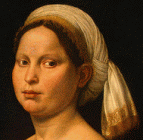
|
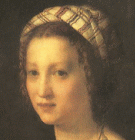
|
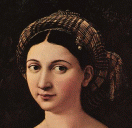
Right: Gentile Fabriano painting (Florence, 1425)
|
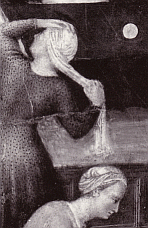
|
the front, with the rolled material would
around this and a tail at the back. The second appears to be
have alternate wrapping. There is no visible bit of material
on the front of the head. This appears to be wrapped
similarly to :
Other_Articles_V_Turban. Finally, on the far right, I was lucky enough to find this
picture in one of my favourite books - Italian Renaissance Interior 1400-1600, by Peter
Thornton. p177 (Far Right) This looks very similar in shape to the
first picture by Giuliano Bugiardini.
My Theory on wrapping the Florentine
way:
|
I will post pictures of how it looks, when I get a decent
pic (and get more practice).
By looking at the first and last pictures above, it appears
to me that one end of the wrap (with gold fringe) is placed
against the front of the head (as seen in Burgiardini). The
final (Fabriano) picture appears to show the material is
then brought forward. (looking at the bottom right woman in
profile) This would give a similar appearance to the folds
as seen here. The wrap is then wound, in the case of the
upper right woman, from the left to the right. It would have
to be wound several times. Finally, as in Bugiardini's
portrait, the end is tucked through the wrapped material
(forward, under up through and out the back) to leave the
decorated end free. Both Budiardini and Raffaello's
Portrait of a Young Woman have only one free end
hanging out the back and a slight straight bit of cloth
visible under the wrapped section This is consistent with
the Fabriano painting, seen from the other side.
|
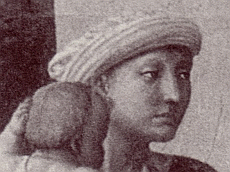
|
(UPDATE: March, 2006) Above is a
picture I have just found (right), is also from Dressing
Renaissance Florence (p155). It is a detail from Masaccio, The
Ditribution of the Goods of the Church (1425) .
Though almost a century earlier than the Bugiardini portrait,
it is similar in shape. This painting also shows similar folds at the
back of the headress (as in Fabriano's portrait). On the right is
my first attempt and 2nd attempt at wrapping. Though not quite right,
it is looking at least similar. I will need a lot more practice!Using this method, I have confirmed my earlier belief that I
will need to make a wrap slightly wider next time.
UPDATE: March, 2006
|
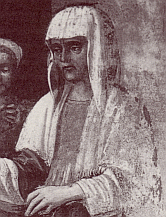
|
I have been looking at other paintings, also from the
late 15th C, and have come to the conclusion that the
Florentine l
|
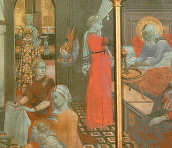
CLICK on pic for more detail
|
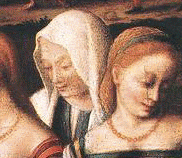
|
inen headwrap is shorter and wider than I
have made mine (so I guess another will be in the works
eventually). The picture left, from Dressing Renaissance
Florence p 156: School of Ghirlandaio, Inventario de
un' eredita dei Buonomini, shows the cowl-like veil,
which appears to be in a rectangle with a fringe on the
ends. This is worn to cover the face and neck from view.
( Dressing Renaissance Florence p 157)
Florentine woman would cover their head when in public.
Upper class woman would be able to afford beautiful and fine
silk veils. The lower classes may have had to do with linen. The
embroidered towels (which showed their skill with the needle) were
decorated, if not fine material.
The second picture, on the right is Sassetta's Birth of the
Virgin (Tuscany). (from Italian Renaissance Interiors)
This shows a linen headwrap (cowl) on the woman on the bottom left, a
similar item (towel) over the shoulder of the central woman and the
linen worn over the head of the woman inthe bed. This is worn
similarly to the woman in the Ghirlandaio painting (upper left).
These and other paintings, suggest that the same linen 'cowl' (which
looks suspisciously like a towel with embroidered edges and
fringing... hmmmm...) is worn in both fashions - like a cowl (or
veil) and wrapped like a turban. This would serve to keep the hair
and material out of the way when doing 'woman's work' around the
house.
Upper right, is a painting by Bacchiacca;The Preaching of Saint
John the Baptist (1520). The central woman is most likely a
servant and not upper classs, as the woman in front of her. The first
three portraits (top:Giuliano Bugiardini Portrait of a Young
Woman, 1525, Portrait of a Young Woman (La Fornarina)
Raffaello 1518-19, Portrait of the Artist's Wife by Andrea del
Sarto , 1513-1514) are most likely not upperclass women either.
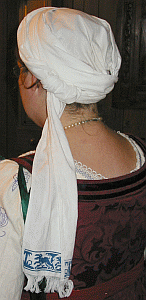
On the night:
the headwrap from the side
|
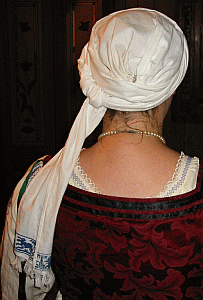
and from the back.
Right: The debut at Newcomers feast
|
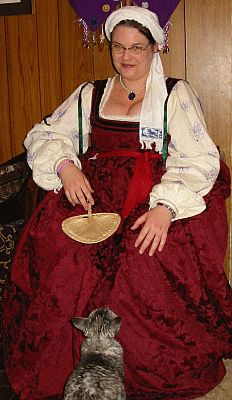
|
Bibliography
- The Needles Excellency A New Booke.
(downloadable)
http://www.shipbrook.com/jeff/bookshelf/details.html?bookid=25
- Arnold Janet, Queen
Elizabeth's Wardrobe Unlock'd, Maney, Leeds, 1988,
ISBN:0-901286-20-6
- Archive of
Stitches from Extant Textiles. www.bayrose.org
- Festive Attyre:
http://homepage.mac.com/festive_attyre/
- Frick, Carole
Collier. Dressing Renaissance Florence.: Families Fortunes &
Clothing. John Hopkins University Press. Baltimore. 2002. ISBN:
0-8018-6939-0
- Nourry, Claude &
de Saincte Louie, Pierre. Patterns Embroidery: Early 16thCentury.
Lacis.
Berkley. 1999. ISBN: 1-891656-16-3
- Thornton, Peter.
The Italian
Renaissance Interior 1400-1600. Harry N Abrams, INc.
Publishers. New York. 1991.ISBN: 0-8109-3459-0
- Veccellio,
Cesare.
Vecellio's renaissance Costume Book. Dover Publications. NY. 1977.
ISBN: 0 48623441X -
- Festive Attyre
http://homepage.mac.com/festive_attyre/research/florentine/portfolio.html
- Oonaghs Own
http://www.geocities.com/oonaghsown/?200622
- Worshipful Company
of Broiderers (Lochac) article.
http://www.sca.org.au/broiderers/Docs/bunnies.pdf
- Tying the
Turban
www.davina.org/turban/sample2.html
- http://www.daviddfriedman.com/Medieval/miscellany_pdf/Other_Articles_V_Turban.pdf
(c) K.Carlisle. 2006
|
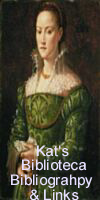
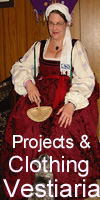
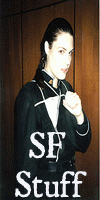
|






